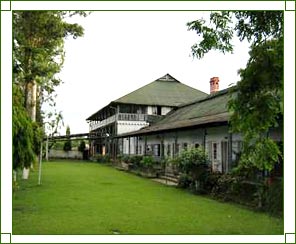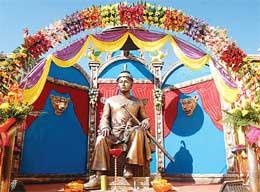How to reach here:
By Air: Jorhat has an airport that is located nearby and it is called the Rowraih Airport.
By Rail: The town of Jorhat has a railway station that receives two trains from Guwahati. The nearest major rail head is the Mariani Junction that is located around 17 km from the town itself.
Best time to visit: October to March.
Languages spoken: Assamese, Bengali, Hindi.
Must eat : Bora, Pokori, Laru.
Famous Restaurants: Sagar, Parag, Numaligarh Dhaba, Flora.
Places you must visit:
The Gymkhana Club was constructed in 1876 by D. Slimmon, the Secretary of the Club in the Seconidhara Village. Ever since its inauguration, the club has served as a venue for horse races. The Governor's Cup is the major event hosted by this club, every year.During 1870's, the region was dotted with tea gardens and there was no recreational facility available for the British or local people in the region, which is why, the foundation of this club was laid. Now, the club has a 9 hole golf course circuit, which is amongst the oldest golf courses in Asia.This club also has facilities for other sports like billiards, lawn tennis and polo. A swimming pool, a gentleman's bar and theatre are some of the other facilities available in this club. It has the Jorhat Gymkhana Ground, where the C.K. Naidu Under-19 Indian Cricket Tournament was organised. The ground is used by the Khelmati Sports Club for practicing cricket.



Hollongapar Gibbon Wildlife Sanctuary is a small sanctuary, covering an area of around 20.98 sq. km. The sanctuary is named so as it is a habitat of the hoolock gibbon, the only ape species found in India. It has semi-evergreen forests and evergreen patches of tea gardens and offers shelter to varied flora and fauna.The sanctuary is home to various mammals, including elephants, tigers, leopards, Assamese macaques, pig tailed macaques, capped langurs and jungle cats. The Indian civet, giant squirrel, sambar, wild pigs and barking deer can also be spotted inside the sanctuary.The sanctuary is inhabited by various resident as well as migratory birds, such as the Indian pied hornbill, hill myna, osprey and kalij pheasant. Various species of reptiles found in the sanctuary include the Indian tent turtle, Indian python, common monitor lizard and Indian cobra.



Nimati, also known as the Nimatighat is counted amongst the important river ports of the district, as well as of Upper Assam. The ghat also serves as a link for ferry boats that operate from the river port to the Majuli Island, Kamalabari and Auniati.

Raja Maidam is a vault on the southern bank of the Toklai River, in the north of Jorhat. This vault preserves the remains or ashes of the erstwhile King Purandar Sinha. This maidam was constructed after his death, on 1st October 1894.


Karanga, a small village of the Jorhat District, is renowned for smithereens that successfully caters to the demand of neighboring tea estates and natives.

Sukapha Samannay Kshetra was constructed in the memory of Sukapha, the first Ahom king of Assam. The site is located at Mohbandha near Dergaon and Jorhat. An excavation project is being operated at the site, to find any remains of the Ahom kingdom.

Tocklai Tea Research Center is situated on the Club Road in Jorhat. This research center is counted amongst the largest and the oldest tea research stations in the world. It was established in 1911, with the main aim to conduct scientific research to find solutions for enhancing the productivity and quality of tea in north-east India.In this center research is conducted on all kinds of tea cultivation and processing, to find ways of increasing the nutritional value of the beverage. The center has 8 research departments, namely botany, soil, agronomy, plant protection, biochemistry, engineering and manufacturing technology, statistics and agricultural economics, and tea tasting.


Bangalpukhari is a famous water tank that lies in the southern part of Jorhat City, near the Na-ali. The tank was constructed by Rupsingh Bangal in 1739, after killing the Badan Barphukan, an Ahom governor. Badan Barphukan captured Burmese soldiers and also tortured the people of Assam.In the month of Sravana of Saka, Rupsingh Bangal killed Badan Barphukan, when he was going for bath. For this act of bravery, Rupsingh Bangal was awarded with money, which he utilised for the construction of this tank. The natives of the region do not look at the water of this tank, as they believe it will bring bad luck because it was dug from the money received for killing a human being.

Garh Ali is a historic site constructed during the war between the Ahoms and the Moamarias. A huge embankment named Garh Ali, starting from Seoni Ali and extending up to the Naga Hills, was constructed to safeguard the Ahom Kingdom. It is also referred to as the Bibuddhi Ghar, owing to the confusing pathway.

Dhekiakhowa Barnamghar was established by Madhabdev, a saint reformer of the 16th century. This shrine is situated within the boundaries of Dhekiakhowa Village near Jorhat. The saint reformer started this center for preaching Vaishnavism.This center contributes towards the social and cultural welfare of the natives. It has been in existence for more than 461 years. The shrine played an important role in propagating the Eka-sarana religion and achieving unity among the natives of Assam.


Kunwari Pukhuri on the Trunk Road, is famous for a huge tank that was constructed by Parbatia Kunwari, the granddaughter of the Ahom king, Sataialia Dilabandha Borgohain.

Thengal Bhavan is the site where the first daily Assamese newspaper was published. It is also famous as the site from where the first daily newspaper in any language was published from a village, in India. This centre was built by Raibahadur Shiva Prasad Barooah in 1880. Later in 1929, he established a printing press for weekly newspapers in the local language.




Cinnamora Tea Estate was established by Maniram Dewan, a sirastadar of an assistant commissioner, who worked under the British administration at Jorhat. Established in 1850, this estate is the first tea garden of Assam.

No comments:
Post a Comment